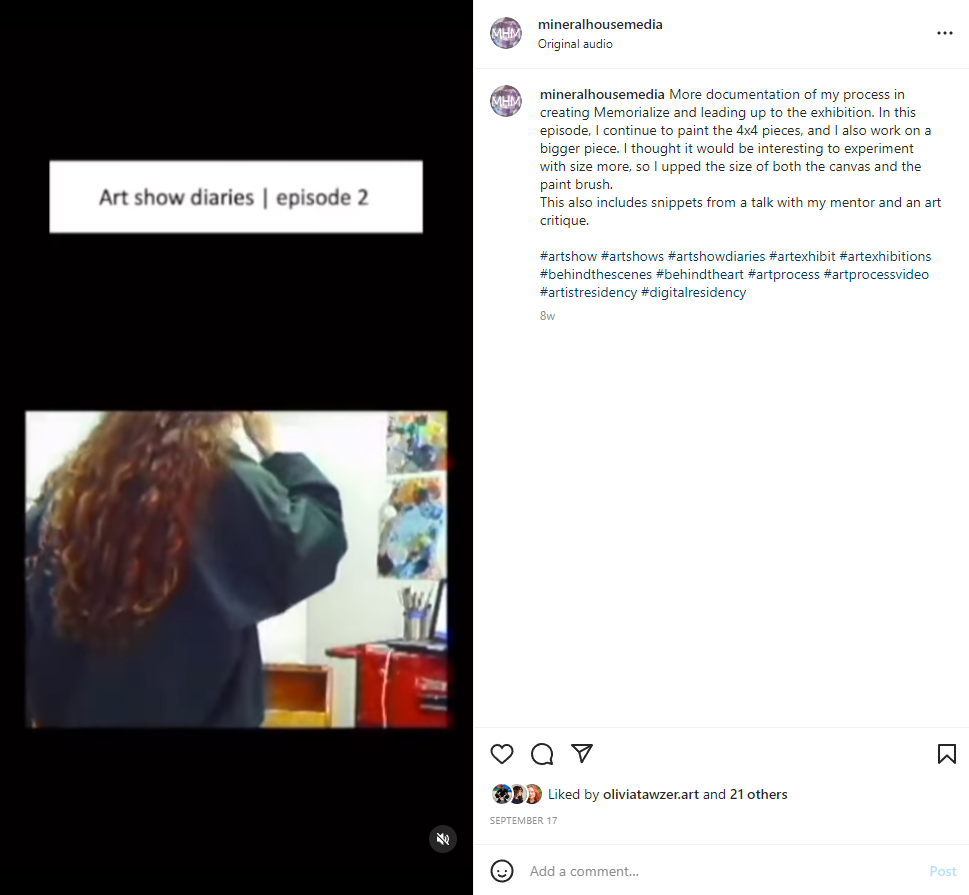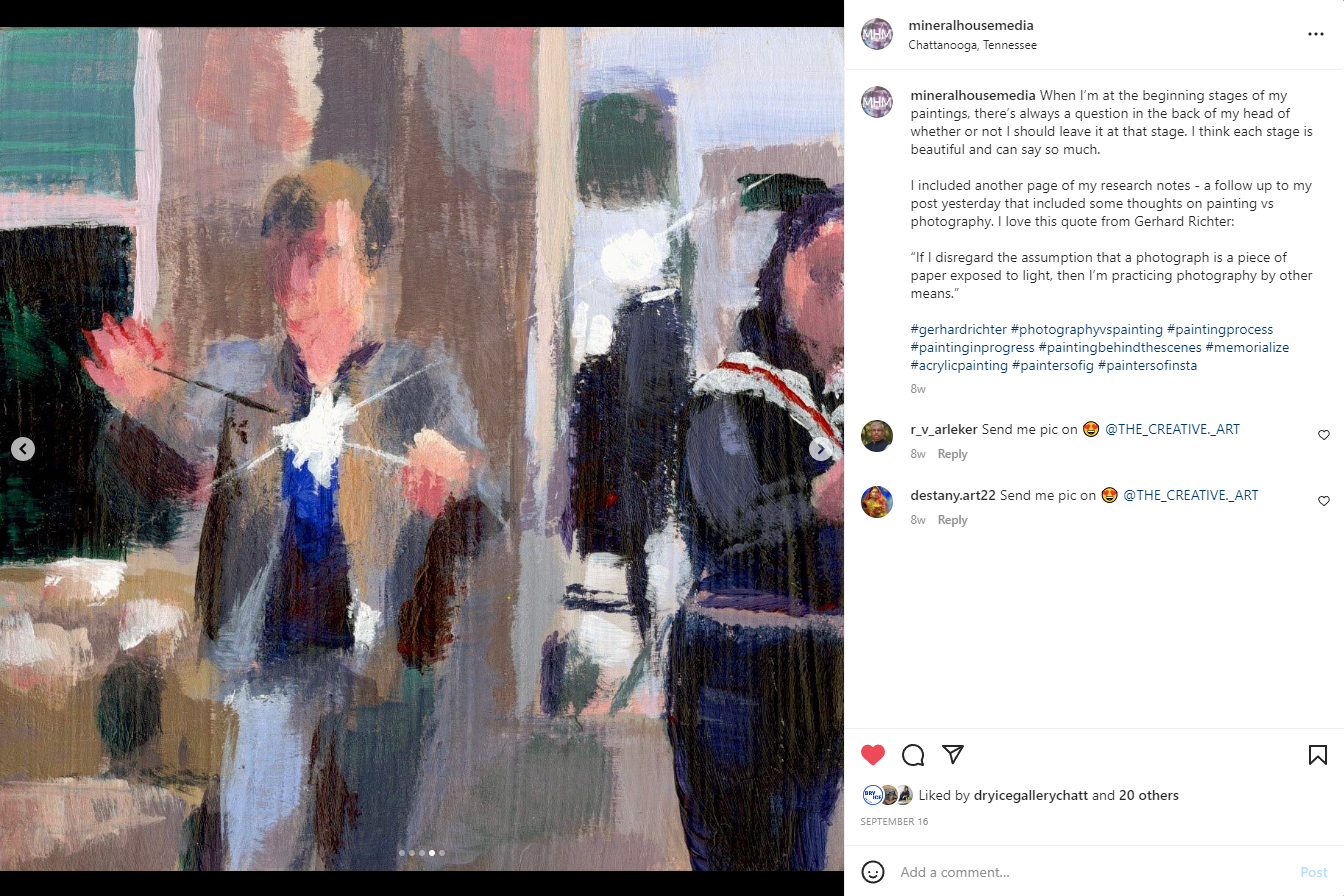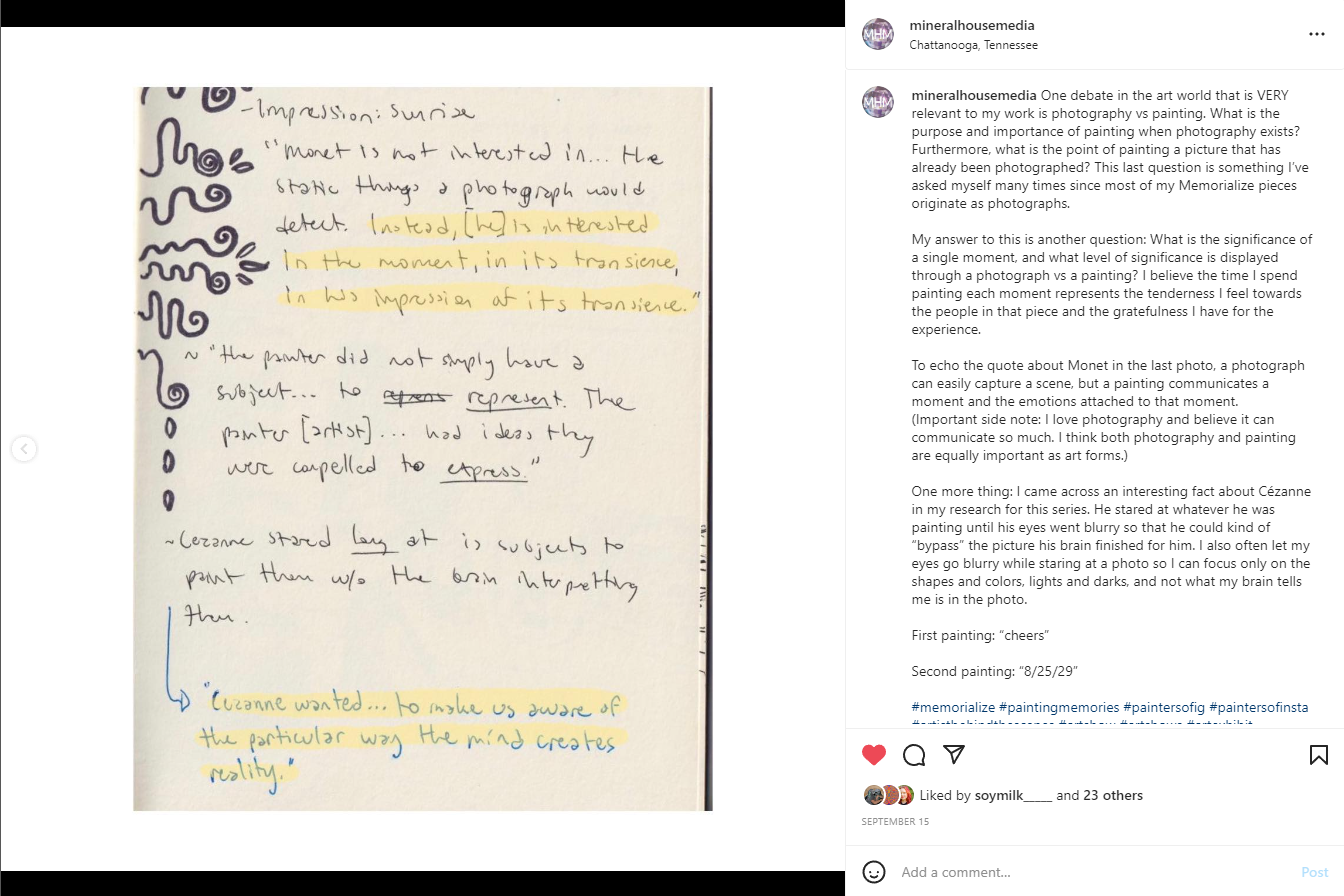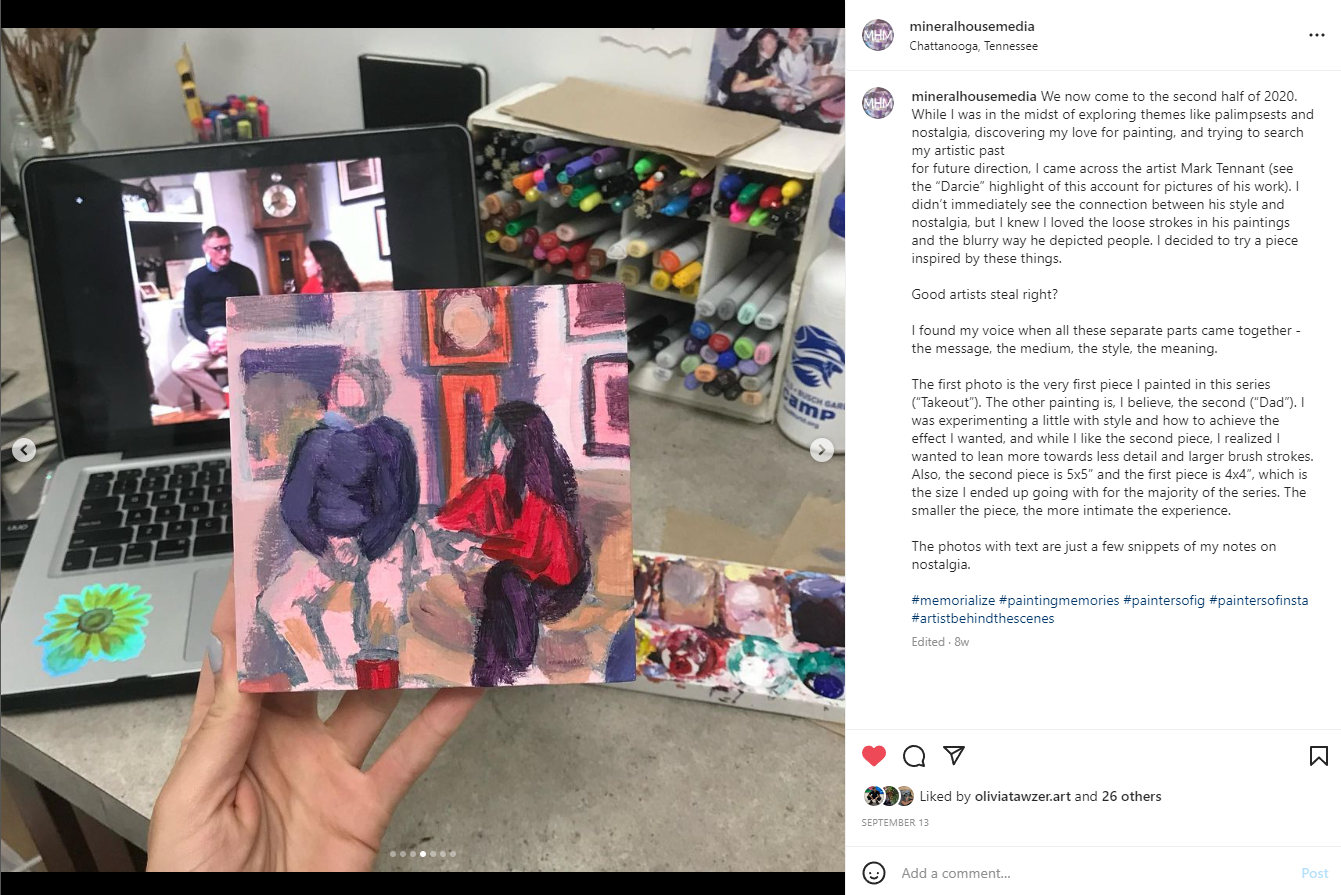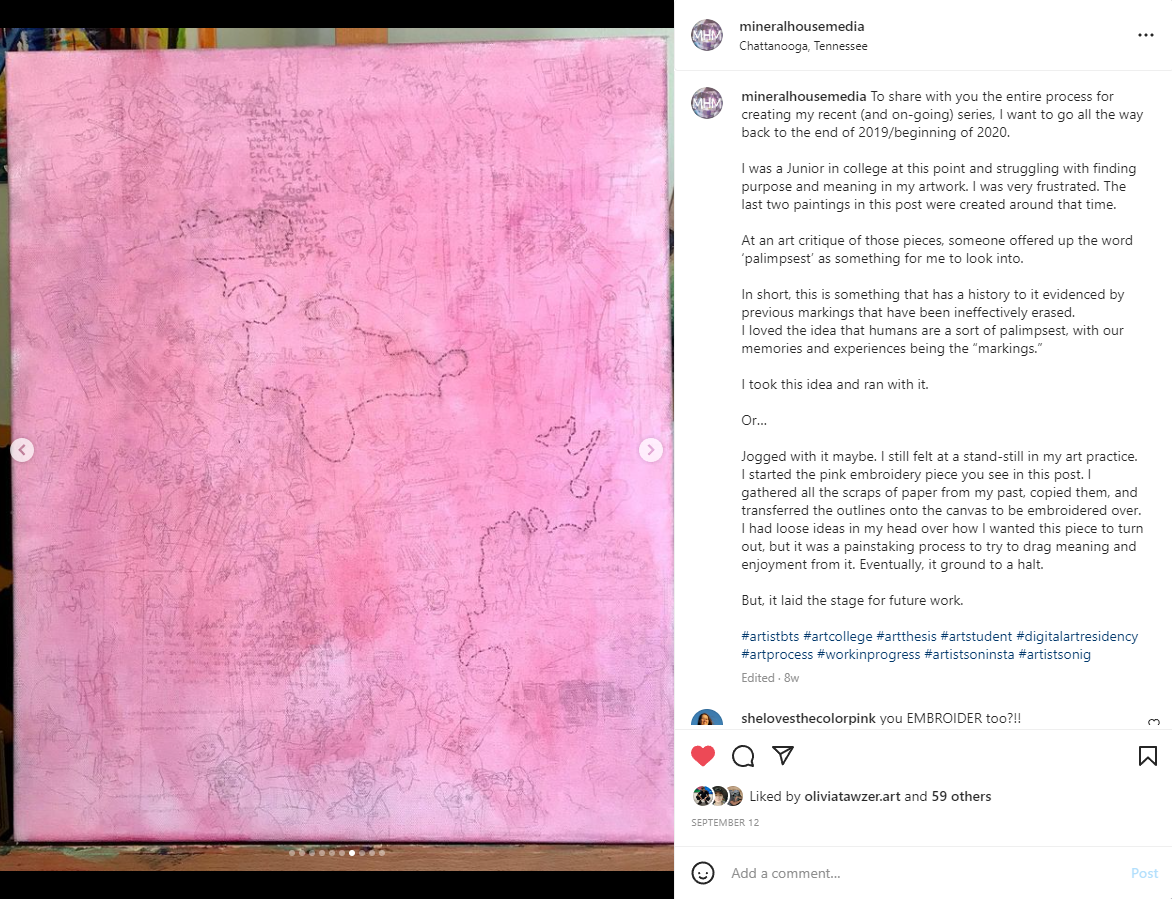Interview with Darcie Denton
Interview with Darcie Denton
September 2022 Digital Resident
A conversation with Clay, Olivia, & Larkin of Mineral House Media
MHM: You mentioned that the video documentation of your process and life as an artist is a big part of your practice. Can you talk more about this aspect of your studio practice? How do you balance social media and video documentation with making work?
DD: I started a YouTube channel in 2015 and started consistently vlogging in 2017 when I began college. I’d seen other college art students do this on their own channels and thought it would be fun to film the whole journey. I kept this up throughout college and after, amassing a total so far of over 70 vlogs.
While I’ve loved this way of expressing myself, documenting and sharing my life, it’s brought me face to face many times with the question of its relevance to my art career. Is it worth it? Does it get in the way of my more “serious” art? Is it even respected in the art world? This all came to a head in December of 2020 when I was almost done with the Art College Vlog series and forced to think about what came next. I came to two conclusions:
First, vlogs, video documentation, ediaries - whatever you want to call them - are all about preserving memories. They are wells of nostalgia. It became very obvious to me that they are indeed part of my art practice, almost at its core, as I explore the importance and effect of nostalgia in my other painting work. From that point, I actually saw my videos as pieces of art. Collected sounds and visuals that I painstakingly crafted into one story. This mindset shift brought a new perspective to my video work, and I started a new vlog series titled “The Visual Diary of thatoneartist” (thatoneartist is my screen name).
Secondly, I can make whatever the heck I want. Isn’t that why artists exist in the first place? I don’t want to let expectations and rules, in the art world or outside of it, real or imagined, get in the way of how I express myself creatively.
In terms of social media as a whole, sometimes I love capturing and sharing my work, and other times, social media feels like a “necessary evil.” It’s all about finding the balance and boundaries. I try to always put my artwork first, and I often go by how I’m feeling. If filming a specific piece doesn’t feel right to me, I won’t do it. If I go heavy with vlogging one month, I might take a break the next month. Social media is good and helpful, but it’s not the priority.
MHM: When does a painting feel finished to you? How much information do you want to give the viewer?
DD: The short answer is that I rely on my artist instinct. There’s just a point in every piece that feels cohesive and finished to me. Throughout all my work, I tend to lean more towards impressionism than realism. However, each painting ends at a different point along this spectrum. Even to look solely at my Memorialize series, you’ll see that certain pieces have more detail and others have less. Sometimes, once I feel there is just enough depth throughout the painting for it to be interesting to the eye, I might leave it as is. Other times I may go further with the details, hinting at facial features, pushing the lights and darks. The one consistent tool I use to keep the paintings loose is a 1-inch wide brush (the panels are 4x4 inches), and I don’t use any smaller brushes. I also will occasionally time myself for 15 to 20 minutes so the timer will tell me when to stop.
MHM: Can you talk more about the importance of scale in your “Memorialize” series? Do you see yourself scaling up in the future?
DD: Tiny art holds great significance. While large pieces are often proclaiming things and making grand statements, small pieces invite the viewer in for an intimate moment. Sharing your memories with someone is one of the most intimate experiences two humans can share, and Memorialize is essentially me inviting the viewer into my memories and letting them communicate with the viewer’s own sense of nostalgia.
I’ve created two bigger pieces within this series - one 24x24 inch painting and one 4x4 foot painting. For both of these I also scaled up the brush size. Furthermore, the 24x24 piece was on a canvas, but the 4x4 foot one, like every other piece in this series, was on a wood panel, making it very heavy. I used latex house paint from various hardware stores for the latter, and it was a very interesting challenge. The size, limited color palette, and reference picture chosen produced a very different feeling from my other small pieces, an almost foreboding and unsettling feeling (at least according to those who critiqued this piece).
MHM: Where do you source the photos that you use as source material for your paintings? Do you take them yourself, collect them from other people, or a combination?
DD: For almost all of my paintings, I use reference pictures taken by myself. I like to be in charge of the entire creative process in this way. This was especially important for the Memorialize series because the references are all my own memories. I scoured my phone for photos of raw, candid moments that captured people at their most natural, photos that portrayed them in a way that most closely represents how I see them in real life. In other words, I tried to avoid photos that were too posed.
MHM: How do you think about the translation from photograph to painting?
DD: I think making a painting of a photograph suggests more significance in the moment depicted. This is not to say photography isn’t a stand-alone medium in and of itself, but the way I use photography is as a means to an end. The photo saves the moment which I will translate into paint later. I am aware of the debate between painting and photography and how the relevance of painting has been challenged, but I believe painting will always carry significance and be an irreplaceable medium to translate feeling, importance, and a great many other meanings.
When it comes to the technique of painting from the reference photo, one trick I like to use is intentionally unfocusing my eyes while staring at the photo. This way, I can better observe the larger shapes and general colors instead of getting lost in the details too soon.
MHM: When did you know you wanted to pursue art as a career? What has your journey looked like?
DD: Though I’ve always loved art, I didn’t decide to pursue it seriously until early high school, and even then I didn’t decide on it as my main career until the end of high school. These decisions were fueled by the success I found on social media, learning about other artists who were working full time, and the encouragement from those around me.
I started an Instagram account in 2014 as a simple way to have all my art in one place whenever a family member or friend asked to see it. But soon I realized the potential that Instagram had for artists. It pushed and helped me in many ways, introducing me to the greater online art community, encouraging me to try new art styles and mediums, and empowering me to grow in skill, audience, and confidence. High school is also the time I started doing commissions for people, mostly in colored pencil (my preferred medium at that time), and sold my first original painting.
During my senior year of high school, I decided to major in Fine Art at Southern Adventist University. This is when I started documenting my college experience and art practice through video. College grew me in many ways. My art practice matured, I was introduced to the theoretical and academic world of art, and I met many artists that are now part of my own community. My first solo art show, Memorialize, was my senior thesis and the grand finale to my college experience.
Since graduating, I’ve been on the “artist grind” in terms of meeting new people, immersing myself into the Chattanooga art scene, and applying to residencies, shows, galleries, and publications. My work has been shown in various galleries, shows, and businesses around Chattanooga, and one of my Memorialize pieces is currently in upstate New York for a small works show. I’m working hard to support myself by selling art online and in markets and taking commissions, in addition to working a part time job remotely, occasionally doing freelance design and video work, and dog sitting. My life is pretty busy, but the luxury of being in charge of my own schedule and dedicating most of my time to pursuing my goals is worth it..
MHM: What does a standard studio day look like for you? How do you maintain your practice?
DD: I’ve been struggling with dedicated studio time since I graduated from college (Adult life is no joke). However, I do manage to squeeze out a day or at least a few hours for art every now and then. When I get that precious time, I like to ideally begin with a slow morning - journal time, quiet moments, a walk or some yoga. Then I’ll start some music on my phone or play a record to get my brain to settle down and narrow in on the art at hand. These days, that art may be a 2-3 hour study of a flower vase, a piece in the realm of nostalgia, or a portrait commission.
I’ve found that my life cycles through different “seasons” where some weeks I find more time and energy for certain tasks while others have to take a backseat. For example, one week I may need to make market prep a priority, and the next week I can put more time into art making.
On top of this, I also have to balance my personal art practice with commissioned work. I’ve learned that it’s very important to play as an artist, so in this phase of my life most of my personal work time is dedicated to art that I enjoy making. But eventually I would like to get back into artist research. I do make time to continue pursuing and exploring the topic of nostalgia and have a few projects in the works, but I just don’t get to work on them as often as I would like to.
MHM: Being an artist means putting yourself out there and accepting both success and failure. Is there an accomplishment you’re proud of, or a rejection or failure you learned from that you would like to share?
DD: Being an artist does mean inviting so much rejection into your life, and as one who is still at the beginning of her art career, I feel this in my bones. But that just means I celebrate the successes even more. Possibly my greatest accomplishment at this point in my life was at the beginning of 2021 when I won first place in a business pitching competition at Southern Adventist University and received $5,000 for my art business. I celebrate all the smaller accomplishments too - being accepted into galleries and shows, invited to talk in front of classes, getting big commissions, having a good market day - and recognize them all as little steps moving steadily forward. As for “failure”, the one at the forefront of my mind is my experience with markets this year. This is my first year selling at art and farmers markets, and I’ve had a lot of disappointing days. They are both physically and mentally exhausting. But I remind myself of all the good things surrounding them - the people I meet, the lessons I learn, the money I make (even if it can sometimes be lacking), and the experience I’m gaining. Slowly but surely I’m finding my place in this art world, learning what works for me, where my audience is, what I want to say, and how I can remain true and kind to myself. Always moving forward.
MHM: Is there any advice you have received that has stuck with you?
DD: Artists need to play. I mentioned this earlier in the interview, and it’s a piece of advice one of my college professors gave me while I was in a studio class. It’s also something that has repeatedly come up in things I read and hear. In The Artist’s Way, for example, Julia Cameron repeatedly emphasizes how important it is for creative individuals to make room in their lives for frivolity, self-care, wonder, and play. It’s where our creativity thrives, and we artists need to make every effort to not squeeze that out of our lives.
MHM: What are your thoughts on memory and preservation of the past? Is it important to preserve these moments?
DD: I actually have mixed thoughts about this. Even though I am someone who loves to preserve the past, I also think there is something to be said for experiencing moments without documentation and letting them live organically in your head for however long they last and in whatever form they take. I do think we live in a time where moments are often over documented. Memories that are documented are useful to inform the present and the future. They can teach you a lot about yourself and help you put things in perspective. They can also bring joy in remembering and help you value the present and the people in your life. This is why I support documentation. But I think there is an unspoken balance to be found. There exist certain moments with a sacredness that should be left untouched by video or photo documentation, such as the ecstasy one might feel during a specific song at a concert. Moments like that deserve full attention instead of a divided attention with one side deciding which camera angle is best and making sure the video is still recording.
MHM: What other artists, music, colors, etc. are influencing and inspiring you right now?
DD: The artists who continually inspire me are Mark Tennant, Erica Lee Sears, and Sari Shryack, among many others. I’ve also recently been fascinated with tiny galleries and dioramas I’ve seen around Chattanooga and on TikTok. In Chattanooga’s Wavelength Space, there is a miniature replica of their gallery made by Quin Sol, and I recently met Sergio Suárez in his residency at Stove Works where he showed me a tiny gallery he and a collaborator created. Marina Totino is an artist on TikTok whose creation of an extremely detailed miniature video store was greatly inspiring. Because of these and more, in conjunction with my interest in nostalgia, I’m beginning to experiment with turning old dollhouses into miniature galleries or some other kind of diorama.
Music is a big part of my life too and certainly feeds my creativity. One artist whose music always puts me in a creative mood is Sevdaliza. Other current favorite artists that fuel my artistic mind are Dora Jar, Charli XCX, Jockstrap, and Caroline Polachek. There’s also a beautiful song by Bernache that I recently created a video piece involving lots of blue paint, though I doubt that will ever see the light of day.
Other pieces of inspiration and influence in my life include the color red, which is unofficially my favorite color, the beauty of autumn, spiritual deconstruction and reconstruction, the book The Artist’s Way, a couple parks I like to walk at and meditate in, and a monthly art night I’ve begun hosting at my house.
Darcie Denton is a fine artist based in the United States. She has run an Instagram account for 7 years and a YouTube account for 6 years where she shares her art, her life, and the lessons she has learned along the way. She dedicates her art and her online presence to make the world beautiful.



